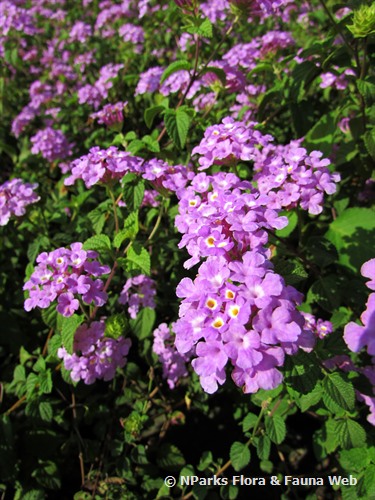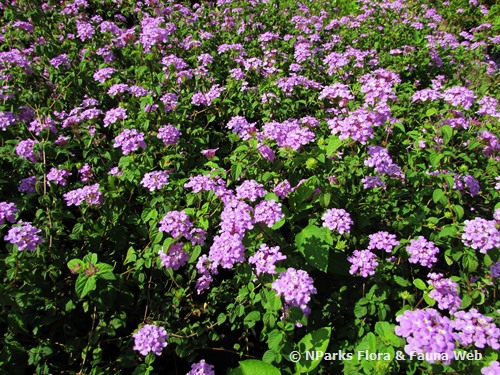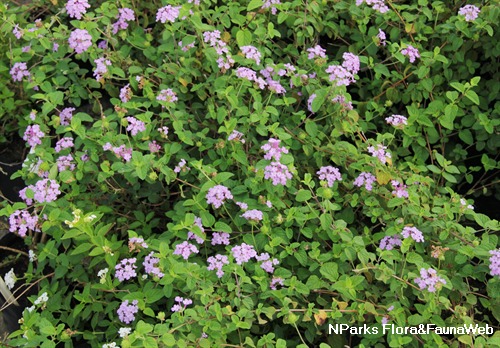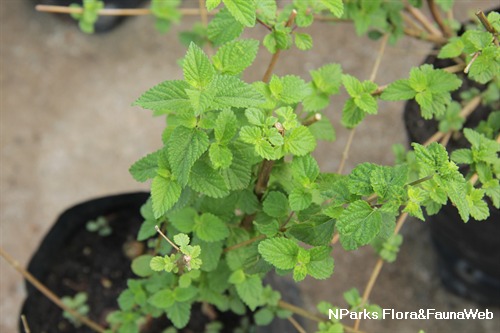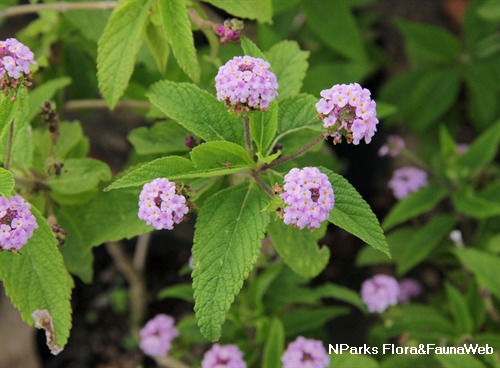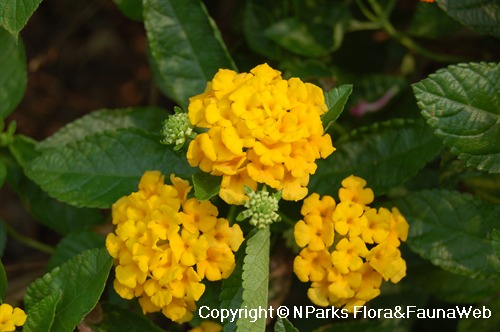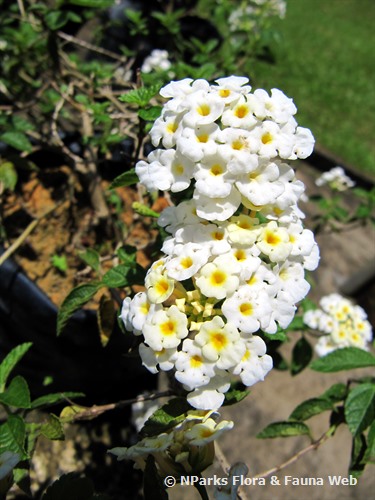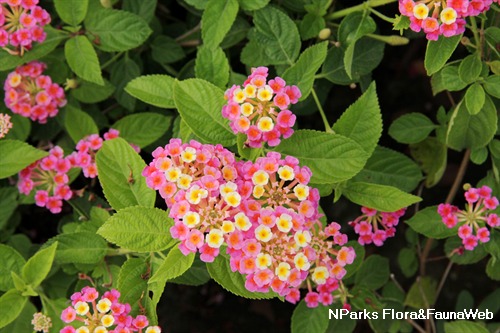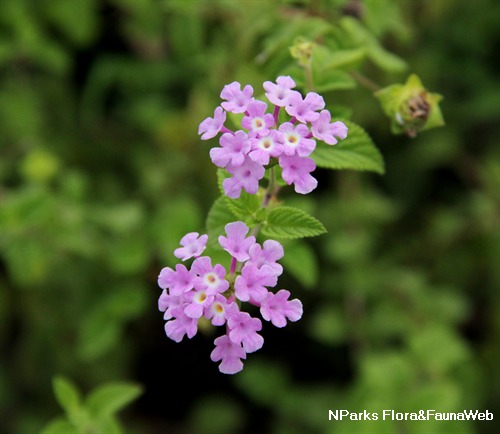
Back
Lantana montevidensis
| Family Name: | Verbenaceae |
| Synonyms: | Lantana sellowiana |
| Common Name: | Trailing Lantana, Polecat Geranium |
Name
Classifications and Characteristics
| Plant Division | Angiosperms (Flowering Seed Plants) (Dicotyledon) |
|---|---|
| Plant Growth Form | Shrub |
| Lifespan (in Singapore) | Perennial |
| Mode of Nutrition | Autotrophic |
| Plant Shape | Weeping / Pendulous |
Biogeography
| Native Distribution | Uruguay |
|---|---|
| Native Habitat | Terrestrial |
| Preferred Climate Zone | Tropical |
| Local Conservation Status | Non-native (Horticultural / Cultivated Only) |
Description and Ethnobotany
| Growth Form | Low-growing shrub, spreading out about 2 - 3 m and growing up to about 0.5 m tall. They sometimes form dense mats of vegetation on the ground. |
|---|---|
| Foliage | Opposite arrangement of leaves, measuring about 1 - 4 cm long and 0.5 - 2 cm wide. Leaves are ovate-shaped and have finely toothed margins. Leaf blades are rough to touch on the upper surface while softly hairy (pubescent) on the undersides. |
| Stems | Slender four-angled stems, becoming woody upon maturity. and more or less cylindrical. The stems sometimes produce roots at the nodes when come into contact with soil. |
| Flowers | Small, light purple flowers with a whitish-yellow throat, measuring about 1 - 1.5 cm long and 0.5 - 1 cm wide; tubular in shape and borne in clusters. The flowers on the outer edges will open first followed by the others opening inwards. |
| Fruit | Fruit is a fleshy berry, measuring about 0.5 - 0.8 cm wide, turning from green to purple upon maturity. |
| Habitat | Found in tropical and sub-tropical environments, in hillsides, railways, roadsides and disturbed areas. |
| Taxonomy | Genus name Lantana is the modern Latin name of the genus name Viburnum. |
| Cultivation | Grow plants in moist, well-drained soil in full sun. The plants can tolerate part shade but they best flower in full sun. They also tolerate sandy to slight dry soils. If grown in container, they are less tolerant to dry soil than those grown in the ground, therefore should be watered regularly. |
| Etymology | The genus Lantana is an old Latin name for Viburnum. The species epithet montevidensis refers to the location of the plant which is found in Montevideo, Uruguay. |
Landscaping Features
| Landscaping | This plant is fast growing, easy to maintain and tolerant to hot and dry conditions. The flowers are attractive to butterflies. It is also an excellent plant for planters and containers for its cascading stems. It tolerates salty conditions as well, which makes it suitable for coastal planting. |
|---|---|
| Desirable Plant Features | Fragrant (Foliage), Ornamental Flowers |
| Landscape Uses | Coastal, Parks & Gardens, Small Gardens, Groundcover, Container Planting |
| Usage Hazard - Cons | Toxic Upon Ingestion |
Fauna, Pollination and Dispersal
| Fauna Pollination Dispersal Associated Fauna | Butterfly-Attracting (Flower Nectar) |
|---|---|
| Pollination Method(s) | Biotic (Fauna) |
Plant Care and Propagation
| Light Preference | Full Sun |
|---|---|
| Water Preference | Moderate Water |
| Plant Growth Rate | Fast |
| Rootzone Tolerance | Drought Tolerant, Well-Drained Soils, Saline Soils / Salt Spray |
| Potential Problems | No serious insect or disease problems. |
| Diseases | Powdery mildew or leaf spot may occur if plants are grown in shaded locations. |
| Propagation Method | Seed |
Foliar
| Foliage Retention | Evergreen |
|---|---|
| Mature Foliage Colour(s) | Green |
| Mature Foliage Texture(s) | Rough |
| Prominent Young Flush Colour(s) | Green |
| Young Flush Texture(s) | Rough |
| Foliar Type | Simple / Unifoliate |
| Foliar Arrangement Along Stem | Opposite |
| Foliar Attachment to Stem | Petiolate |
| Foliar Shape(s) | Non-Palm Foliage (Ovate) |
| Foliar Venation | Pinnate / Net |
| Foliar Margin | Serrate / Toothed |
| Foliar Apex - Tip | Acute |
| Foliar Base | Rounded / Obtuse |
| Leaf Area Index (LAI) for Green Plot Ratio | 4.5 (Shrub & Groundcover - Dicot) |
Floral (Angiosperm)
| Flower & Plant Sexuality | Bisexual Flowers |
| Flower Colour(s) | Purple |
|---|---|
| Flower Texture(s) | Smooth |
| Flower Grouping | Cluster / Inflorescence |
| Flower Location | Axillary |
| Flower Symmetry | Radial |
| Individual Flower Shape | Tubular |
| Inflorescence Type | Umbel |
| Flowering Period | Free-Flowering |
| Flower Lifespan on Plant | Several Days |
Fruit, Seed and Spore
| Mature Fruit Colour(s) | Purple |
|---|---|
| Fruit Classification | Simple Fruit |
| Fruit Type | Fleshy Fruit , Non-Accessory Fruit |
| Seed Description | Each fruit has one seed which is hard and about 4 mm long. |
| Seed Quantity Per Fruit | Few (1-5) |
Image Repository
Others
| Master ID | 891 |
|---|---|
| Species ID | 2185 |
| Flora Disclaimer | The information in this website has been compiled from reliable sources, such as reference works on medicinal plants. It is not a substitute for medical advice or treatment and NParks does not purport to provide any medical advice. Readers should always consult his/her physician before using or consuming a plant for medicinal purposes. |

